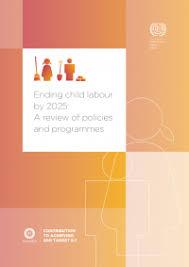
http://www.ilo.org/global/about-the-ilo/newsroom/news/WCMS_595716/lang--...
Find here the full report: http://www.ilo.org/ipecinfo/product/download.do?type=document&id=29875
GENEVA (ILO News) – The ILO has called for stepped-up efforts to “consign child labour to the dustbin of history,” in a report released to coincide with the IV Global Conference on the Sustained Eradication of Child Labour , held in Buenos Aires from 14 to 16 November.
“We are moving in the right direction, but we have to do so at a much faster rate,” the ILO said in its report Ending child labour by 2025: A review of policies and programmes .
The report lists four key policy ‘pillars’ in the fight against child labour: Boosting legal protections, improving the governance of labour markets and family enterprises, strengthening social protection and investing in free, quality education.
- Legislation alone cannot eradicate child labour, but at the same time, it won’t be possible to eradicate child labour without effective legislation. More than 99.9 per cent of the world’s children aged 5-17 years are covered by the ILO’s Worst Forms of Child Labour Convention, 1999 (No. 182) , which 181 countries have ratified . Also widely ratified is the Convention concerning Minimum Age for Admission to Employment, 1973 (No. 138) , which 170 countries have ratified . But turning these standards into national laws remains a major challenge, as is ensuring effective monitoring and enforcement of existing child labour laws. There is also a need for stronger labour inspection systems as it rarely reaches workplaces in the informal economy, where most child labour is found.
- Work for adults and youth of legal working age that delivers a fair income and security means that households do not have to resort to child labour to meet basic needs or to deal with economic uncertainty. Well-designed labour market policies focused on where most child labour persists – in the rural economy and the informal economy – can help curb the demand for child labour. At the same time, establishing regulatory frameworks is critical to addressing child labour in supply chains.
- Continued progress against child labour requires policies that help mitigate the economic vulnerability of households. Accelerating progress towards universal social protection is key, as social protection helps prevent poor households from having to rely on child labour as a coping mechanism.
- There is broad consensus that the single most effective way to stem the flow of school-aged children into child labour is to improve access to and quality of schooling. Getting children off to a good start through appropriate early childhood development, care and pre-primary education programmes is one of the most important strategies for ensuring that children transition successfully from early childhood to school rather than to the workplace.
Global Estimates published in September 2017 indicate that 152 million children aged 5-17 – almost one in 10 – are in child labour globally. Child labour declined since in 2000, but the pace slowed down between 2012 and 2016. On current trends, 121 million children would still be engaged in child labour in 2025.
In adopting the United Nations Sustainable Development Goals (SDGs) in 2015, the international community committed to eliminating all forms of child labour by 2025 . “Now,” the ILO report said, “we must turn this renewed commitment into accelerated action and consign child labour to the dustbin of history, once and for all.”










Add new comment